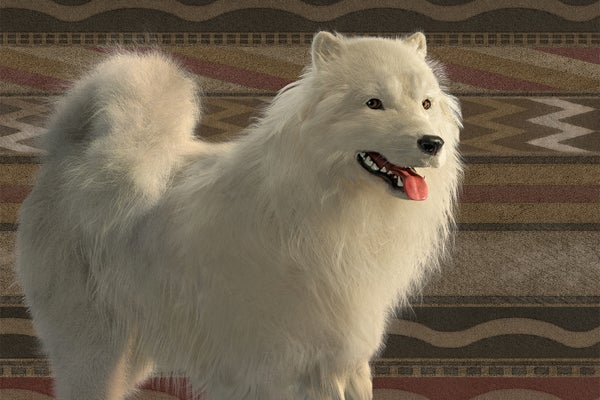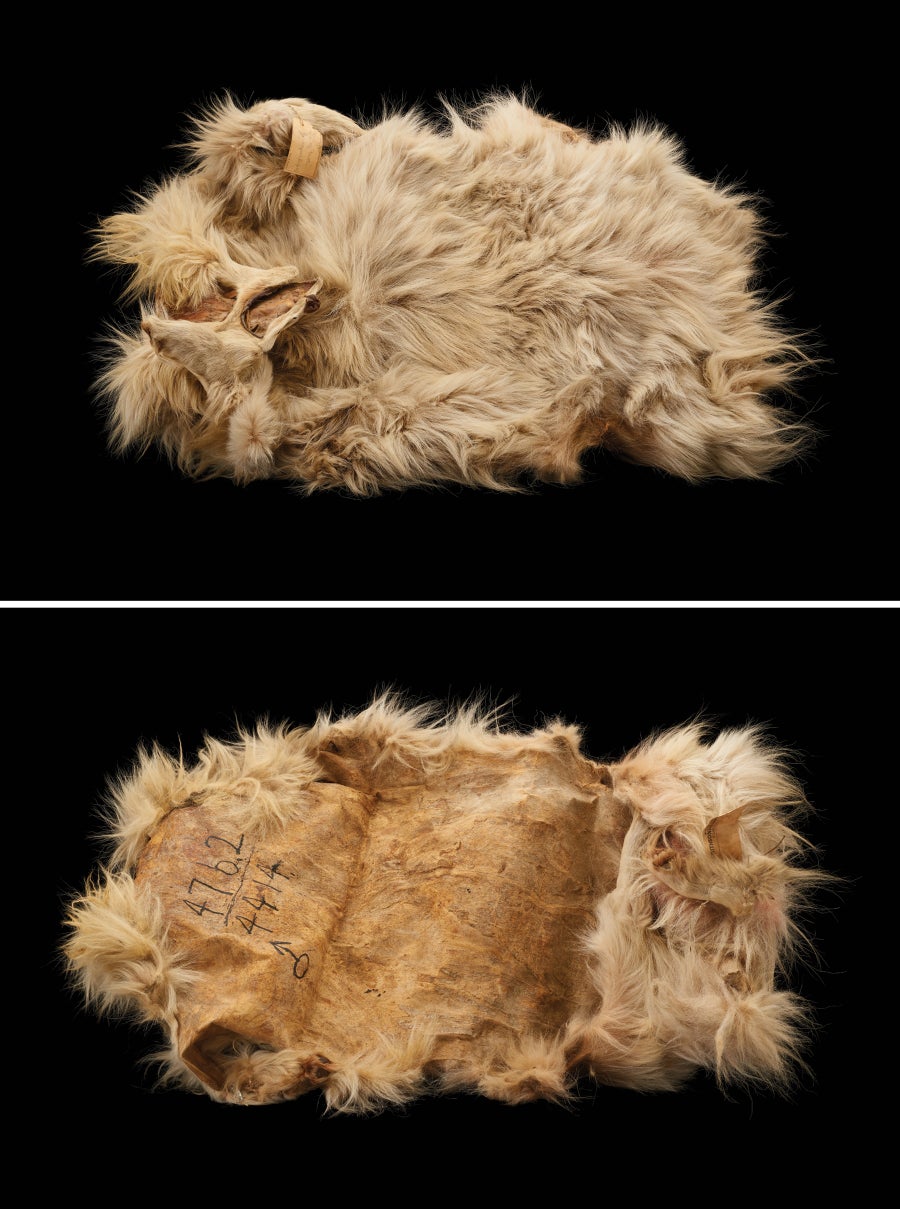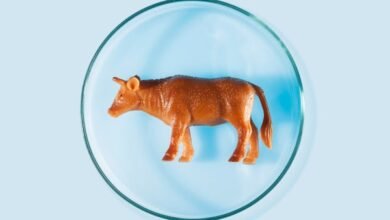
December 18, 2023
4 min read
“Woolly dogs” that were kept by the Coast Salish peoples are now extinct, but researchers were able to see their importance written in the genome of the only known pelt

Full-body forensic reconstruction of a woolly dog based on a 160-year-old pelt in the Smithsonian’s collection as well as archaeological remains. The reconstructed woolly dog stands against a stylized background of a Coast Salish weaving motif from a historic dog-wool blanket. The portrayal of the weaving motif was designed under advisement of the study’s Coast Salish advisory group.
For millennia before Europeans colonized what is now called the Pacific Northwest, small, fluffy, white “woolly dogs,” known as sqwemá:y in one language of the Coast Salish peoples, roamed the coast. The animals were unlike any dog living today. Their hair was so luxurious that Coast Salish individuals used it to make functionally and ceremonially important blankets.
Only one known woolly dog pelt exists today. By analyzing its genes, scientists have now shown just how different these shaggy creatures were from the Yorkshire terriers and Newfoundland dogs that gallivant around modern neighborhoods. The woolly dog “wasn’t a dog as we know it,” says Debra qwasen Sparrow, a master weaver of the Musqueam First Nation. “And DNA has proved that.”
Sparrow is a co-author of new research published December 14 in Science that analyzes the fur of a woolly dog named Mutton, which is currently kept by the Smithsonian National Museum of Natural History in Washington, D.C. Mutton died in 1859, around the time when the tradition of tending woolly dogs was crumbling in the face of the Coast Salish peoples’ forced assimilation and decimation by European diseases. By the early 20th century, the animals had disappeared.
For part of the research, Sparrow shared recollections from her grandfather, who saw some of the last of the sqwemá:y as a young child. “My grandfather would tease a little bit and say it was kind of like they were our sheep,” Sparrow says. “We would herd them—they stayed in packs; we didn’t want them integrating with the other wild animals.”

The Coast Salish peoples often combined the dogs’ woolly undercoat with mountain goat hair and plant fiber to form a thick yarn that weavers then used to craft patterned blankets. They used the blankets in ceremonies and to stay warm, making the sqwemá:y a central part of society. “The relationship to those little dogs was a gift,” Sparrow says.
And the attention with which Coast Salish peoples tended to these animals is inscribed in Mutton’s genome, says Audrey Lin, a paleogeneticist at the Smithsonian National Museum of Natural History and a co-author of the new research. “Dog breeds are inbred in order to maintain a very specific phenotype,” Lin says. “There were signatures of that in his genome, which reinforced what we know culturally—that these dogs were kept by the Coast Salish and very carefully maintained for a very long period of time.”
The scientists’ analyses confirmed that Mutton’s lineage goes back about 4,800 years, Lin says. Although Mutton himself seems to have had a great-grandparent that was a European dog breed, the rest of his genome is distinct and includes several mutations affecting skin and hair that could help produce spinnable fur. “These gene variants, we didn’t see them in any other dogs that we had looked at,” Lin says. Intriguingly, some of these genes cause hair-related diseases or “woolly” hair in humans.
Mutton’s distinctive heritage, retained even as Europeans were encroaching on the Pacific Northwest, is particularly striking. “It just shows how devastating colonialism is,” Lin says. “This ancient tradition of keeping woolly dogs for possibly up to 5,000 years was just gone within a couple of generations.”
With the sqwemá:y now extinct, the Coast Salish relationship with them has become a mere memory. “Settler colonialism has impacted every human and nonhuman being and the relationships between those human and nonhuman beings,” says Kelsey Dayle John, a social scientist at the University of Arizona, who focuses on Indigenous studies and was not involved in the new research.
Sparrow hopes to renew that relationship, looking to create the first traditional blanket in more than a century. Without the sqwemá:y, she’ll have to find another dog whose hair she can spin. She’ll also need to retrace her ancestors’ steps in harvesting mountain goat hair and stripping stinging nettles, which will form the core of her yarn. After spinning the mixture together, she’ll dye it with diatomaceous earth, a crumbly sedimentary rock made of fossilized algae that keeps insects away. Sparrow says she also needs to build a new loom to weave the final blanket that can accommodate a yarn that behaves so differently from her usual wool.
“It’s leading me back to that place of wanting to get as close as I can to the originals,” Sparrow says of seeing science dig into the sqwemá:y and their importance to Coast Salish peoples. “What I want society to understand is the intelligence behind these women who were scientifically putting blankets together.”
Source link



